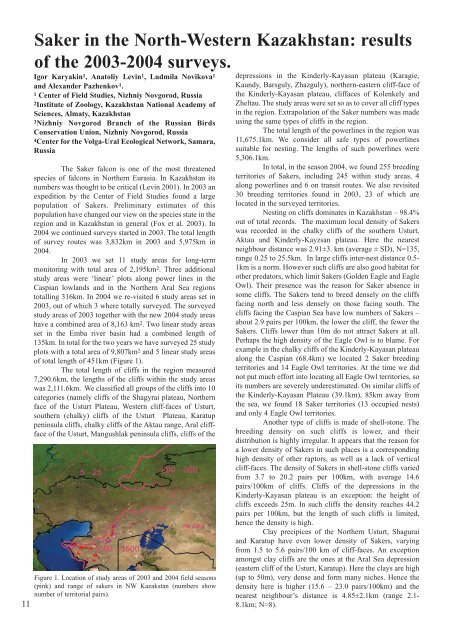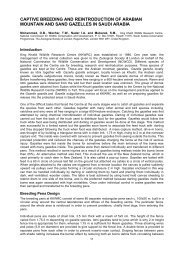His Highness Sheikh Zayed bin Sultan Al Nahyan - Wildlife Middle ...
His Highness Sheikh Zayed bin Sultan Al Nahyan - Wildlife Middle ...
His Highness Sheikh Zayed bin Sultan Al Nahyan - Wildlife Middle ...
You also want an ePaper? Increase the reach of your titles
YUMPU automatically turns print PDFs into web optimized ePapers that Google loves.
11<br />
Saker in the North-Western Kazakhstan: results<br />
of the 2003-2004 surveys.<br />
Igor Karyakin 1, Anatoliy Levin 1, Ludmila Novikova 1<br />
and <strong>Al</strong>exander Pazhenkov 1.<br />
1 Center of Field Studies, Nizhniy Novgorod, Russia<br />
2Institute of Zoology, Kazakhstan National Academy of<br />
Sciences, <strong>Al</strong>maty, Kazakhstan<br />
3Nizhniy Novgorod Branch of the Russian Birds<br />
Conservation Union, Nizhniy Novgorod, Russia<br />
4Center for the Volga-Ural Ecological Network, Samara,<br />
Russia<br />
The Saker falcon is one of the most threatened<br />
species of falcons in Northern Eurasia. In Kazakhstan its<br />
numbers was thought to be critical (Levin 2001). In 2003 an<br />
expedition by the Center of Field Studies found a large<br />
population of Sakers. Preliminary estimates of this<br />
population have changed our view on the species state in the<br />
region and in Kazakhstan in general (Fox et al. 2003). In<br />
2004 we continued surveys started in 2003. The total length<br />
of survey routes was 3,832km in 2003 and 5,975km in<br />
2004.<br />
In 2003 we set 11 study areas for long-term<br />
monitoring with total area of 2,195km 2. Three additional<br />
study areas were ‘linear’ plots along power lines in the<br />
Caspian lowlands and in the Northern Aral Sea regions<br />
totalling 316km. In 2004 we re-visited 6 study areas set in<br />
2003, out of which 3 where totally surveyed. The surveyed<br />
study areas of 2003 together with the new 2004 study areas<br />
have a com<strong>bin</strong>ed area of 8,163 km 2. Two linear study areas<br />
set in the Emba river basin had a com<strong>bin</strong>ed length of<br />
135km. In total for the two years we have surveyed 25 study<br />
plots with a total area of 9,807km 2 and 5 linear study areas<br />
of total length of 451km (Figure 1).<br />
The total length of cliffs in the region measured<br />
7,290.6km, the lengths of the cliffs within the study areas<br />
was 2,111.6km. We classified all groups of the cliffs into 10<br />
categories (namely cliffs of the Shagyrai plateau, Northern<br />
face of the Usturt Plateau, Western cliff-faces of Usturt,<br />
southern (chalky) cliffs of the Usturt Plateau, Karatup<br />
peninsula cliffs, chalky cliffs of the Aktau range, Aral cliffface<br />
of the Usturt, Mangushlak peninsula cliffs, cliffs of the<br />
Figure 1. Location of study areas of 2003 and 2004 field seasons<br />
(pink) and range of sakers in NW Kazakstan (numbers show<br />
number of territorial pairs).<br />
depressions in the Kinderly-Kayasan plateau (Karagie,<br />
Kaundy, Barsguly, Zhazguly), northern-eastern cliff-face of<br />
the Kinderly-Kayasan plateau, cliffaces of Kolenkely and<br />
Zheltau. The study areas were set so as to cover all cliff types<br />
in the region. Extrapolation of the Saker numbers was made<br />
using the same types of cliffs in the region.<br />
The total length of the powerlines in the region was<br />
11,675.1km. We consider all safe types of powerlines<br />
suitable for nesting. The lengths of such powerlines were<br />
5,306.1km.<br />
In total, in the season 2004, we found 255 breeding<br />
territories of Sakers, including 245 within study areas, 4<br />
along powerlines and 6 on transit routes. We also revisited<br />
30 breeding territories found in 2003, 23 of which are<br />
located in the surveyed territories.<br />
Nesting on cliffs dominates in Kazakhstan – 98.4%<br />
out of total records. The maximum local density of Sakers<br />
was recorded in the chalky cliffs of the southern Usturt,<br />
Aktau and Kinderly-Kayzsan plateau. Here the nearest<br />
neighbour distance was 2.91±3. km (average ± SD), N=135,<br />
range 0.25 to 25.5km. In large cliffs inter-nest distance 0.5-<br />
1km is a norm. However such cliffs are also good habitat for<br />
other predators, which limit Sakers (Golden Eagle and Eagle<br />
Owl). Their presence was the reason for Saker absence in<br />
some cliffs. The Sakers tend to breed densely on the cliffs<br />
facing north and less densely on those facing south. The<br />
cliffs facing the Caspian Sea have low numbers of Sakers –<br />
about 2.9 pairs per 100km, the lower the cliff, the fewer the<br />
Sakers. Cliffs lower than 10m do not attract Sakers at all.<br />
Perhaps the high density of the Eagle Owl is to blame. For<br />
example in the chalky cliffs of the Kinderly-Kayasan plateau<br />
along the Caspian (68.4km) we located 2 Saker breeding<br />
territories and 14 Eagle Owl territories. At the time we did<br />
not put much effort into locating all Eagle Owl territories, so<br />
its numbers are severely underestimated. On similar cliffs of<br />
the Kinderly-Kayasan Plateau (39.1km), 85km away from<br />
the sea, we found 18 Saker territories (13 occupied nests)<br />
and only 4 Eagle Owl territories.<br />
Another type of cliffs is made of shell-stone. The<br />
breeding density on such cliffs is lower, and their<br />
distribution is highly irregular. It appears that the reason for<br />
a lower density of Sakers in such places is a corresponding<br />
high density of other raptors, as well as a lack of vertical<br />
cliff-faces. The density of Sakers in shell-stone cliffs varied<br />
from 3.7 to 20.2 pairs per 100km, with average 14.6<br />
pairs/100km of cliffs. Cliffs of the depressions in the<br />
Kinderly-Kayasan plateau is an exception: the height of<br />
cliffs exceeds 25m. In such cliffs the density reaches 44.2<br />
pairs per 100km, but the length of such cliffs is limited,<br />
hence the density is high.<br />
Clay precipices of the Northern Usturt, Shagurai<br />
and Karatup have even lower density of Sakers, varying<br />
from 1.5 to 5.6 pairs/100 km of cliff-faces. An exception<br />
amongst clay cliffs are the ones at the Aral Sea depression<br />
(eastern cliff of the Usturt, Karatup). Here the clays are high<br />
(up to 50m), very dense and form many niches. Hence the<br />
density here is higher (15.6 – 23.0 pairs/100km) and the<br />
nearest neighbour’s distance is 4.85±2.1km (range 2.1-<br />
8.1km; N=8).




